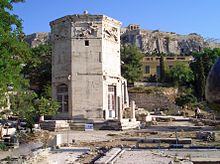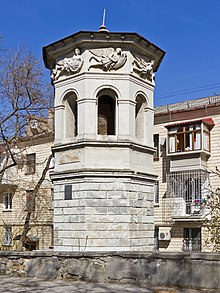Tower of the Winds (Athens)


The Tower of the Winds (also Horologion des Andronikos or Αέρηδες , Aerides ) is an octagonal tower on the edge of the Roman Agora and the best preserved ancient building in Athens . It was built in the late Hellenistic period and served as a clock pavilion with the function of a weather station. The 13 m high tower was designed by the astronomer Andronikos von Kyrrhos in the 1st century BC. Chr.
The tower is first mentioned by Varro (before 37 BC), then by Vitruvius .
description
Pentelic marble was used for construction . According to the mythologically based wind system of the Greeks , the tower has eight sides. A sundial is attached to each of the eight sides of the tower , a ninth was probably located on the southern round annex . Above each there is a relief for one of the wind gods . Each figure (four main and four secondary winds) shows the character of the respective wind through its attributes (e.g. rain, hail, fruit, etc.). There is an entrance each on the northeast and northwest sides. On the roof, the figure was a Triton of bronze , which as a weather vane could turn and rejected the prevailing wind direction each with his staff. In the tower was a water clock and other hydro-powered devices; this was supplied from a water reservoir located on the south side of the tower, which was fed by a pipe from a spring located on the northern slope of the Acropolis .
While the tower once stood in isolation, today it is combined with the Roman agora to form an archaeological excavation site.
reception
Vitruvius mentioned the tower of the winds in his architectural writing and made its 8 or 16 radials the starting point for his considerations on urban planning. The urban planning draft of Karlsruhe , for example, refers to this text . However, the tower was only measured in detail and reconstructed with drawings by James Stuart and Nicholas Revett around 1750 . In her first volume, the Antiquities of Athens , published in 1762 , it was one of the first buildings in motherland Greece to become known in Western Europe and served as a model for many buildings of the 18th and 19th centuries. Among them is that of Leopold III in Germany . Friedrich Franz von Anhalt-Dessau built the Tower of the Eight Winds in Dessau - Mildensee and the Carl Gotthard Langhans observatory (today: Halle observatory in the Botanical Garden of the University of Halle ). The relief depictions of the eight winds were repeated on the corner towers of Tegel Palace in Berlin.
To this day, the tower is cited in the arts, but also in modern architecture, for example in the Tower of Winds in Yokohama by Toyo Ito from 1986 or as a design element in designs by Rob Krier for the Cité Judiciaire in Luxembourg .
Reliefs of the wind gods
| Surname | Wind direction | presentation |
|---|---|---|
| Boreas | north | bearded man with coat and shell that he blows into |
| Kaikias | Northeast | bearded man, pours round objects (hailstones?) from a round sign |
| Ap (h) eliotes | east | Adolescent wearing a coat filled with fruits and cereals |
| Euros | southeast | bearded man wrapped in a cloak |
| Notos | south | Teenager emptying a jug |
| Lips | southwest | Teenager with Steven |
| Zephyros | west | Teenager wearing a coat cloth filled with flowers |
| Skiron | Northwest | bearded man emptying a bulbous vessel |
literature
- Ioannis Travlos : Image dictionary on the topography of ancient Athens. Wasmuth, Tübingen 1971, pp. 281-288.
- Joachim von Freeden: Oικία Kυρρήστoυ. Studies on the so-called Tower of the Winds in Athens (= Archaeologica Vol. 29). Giorgio Bretschneider, Rome 1983, ISBN 8-885-00766-X .
- Hermann J. Kienast : Investigations on the tower of the winds. In: Archäologischer Anzeiger. 1993, pp. 271-275. (Full text)
- Hermann J. Kienast: Ancient time measurement on the agora. New research on the Tower of the Winds in Athens. In: Ancient World. Volume 28, 2, 1997, pp. 113-115.
- Karlheinz Schaldach: The ancient sundials of Greece. Mainland and Peloponnese. Harri Deutsch, Frankfurt am Main 2006, ISBN 978-3-817-11756-7 , pp. 60-83.
- Hermann J. Kienast: The tower of the winds in Athens. Archaeological Funds and Expropriations Treasury, Publications Unit, Athens 2007, ISBN 978-9-602-14584-5 .
- Hermann J. Kienast: The tower of the winds in Athens (= archaeological research. Volume 30). Reichert, Wiesbaden 2014, ISBN 978-3-954-90024-4 ( review by Bryn Mawr Classical Review (English) )
- Pamela A. Webb: The Tower of the Winds in Athens. Greeks, Romans, Christians, and Muslims: Two Millennia of Continual Use. American Philosophical Society Press, Philadelphia 2017, ISBN 978-0-871-69270-2 .
Remarks
- ^ Hermann J. Kienast: The tower of the winds in Athens (= archaeological research. Volume 30). Reichert, Wiesbaden 2014, p. X: “the best preserved ancient building in all of Greece”.
- ↑ The fact that the tower is so well preserved is due to the fact that it was used as a baptistery of a basilica in early Christian times and as a prayer room for the dance of the dervishes in Turkish times . ( Hans Rupprecht Goette : Athens - Attika - Megaris. Travel guide to the art treasures and cultural monuments in central Greece . Böhlau. Cologne / Weimar / Vienna 1993. ISBN 3-412-03393-6 , p. 82).
- ↑ Varro, De re rustica 3, 5, 17.
- ^ Vitruvius, De architectura libri decem 1, 6, 4.
- ↑ Cf. Karlheinz Schaldach: The ancient sundials of Greece. Frankfurt am Main 2006, pp. 78-81.
- ↑ Ulrich Schulze: Urban Planning in Karlsruhe - Paradigm Shift? In: Katharina Büttner, Martin Papenbrock (Hrsg.): Art and architecture in Karlsruhe. Festschrift for Norbert Schneider. Universitätsverlag, Karlsruhe 2006, ISBN 3-86644-050-2 , p. 26.
- ↑ James Stuart, Nicholas Revett: Antiquities of Athens. Vol. 1, London 1762, pp. 13-25, plates 1-19.
- ↑ Otto Waser : Skiron 2 . In: Wilhelm Heinrich Roscher (Hrsg.): Detailed lexicon of Greek and Roman mythology . Volume 4, Leipzig 1915, Col. 1013 f. ( Digitized version ).
Web links
- Horologion of Andronikos, so-called Tower of the Winds in the Arachne archaeological database
- The Tower of Winds (Engl.)
Coordinates: 37 ° 58 ′ 27 ″ N , 23 ° 43 ′ 37 ″ E
